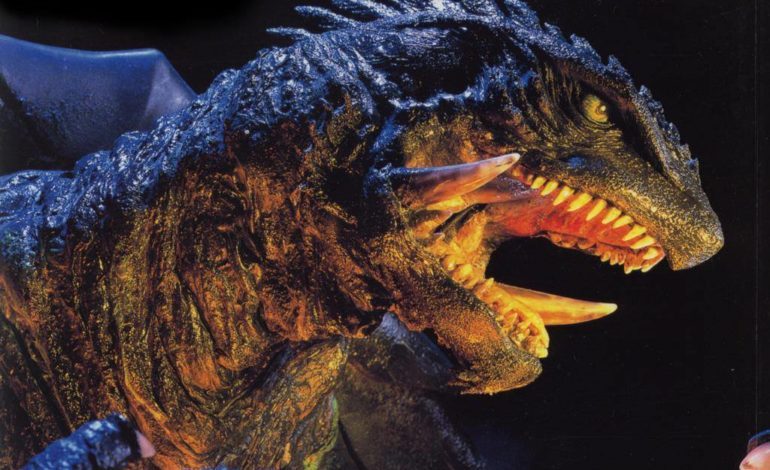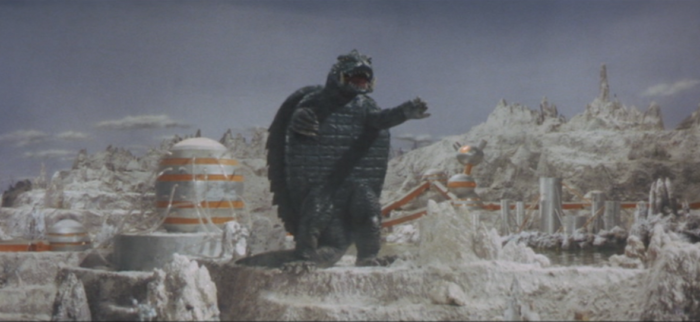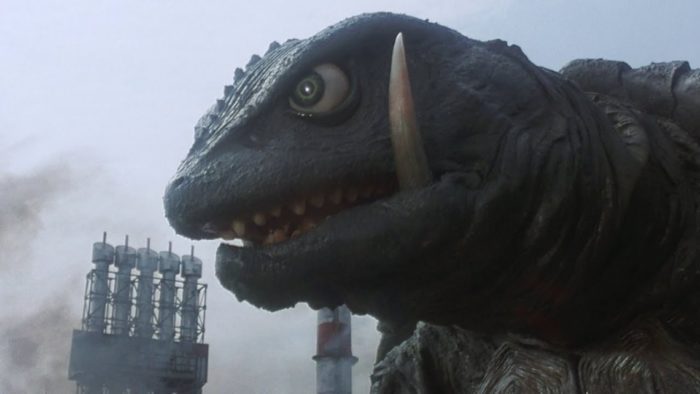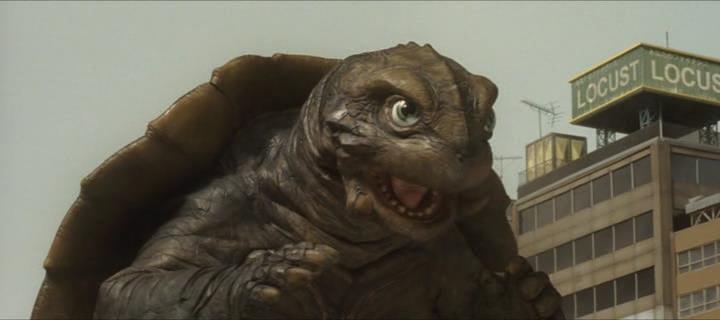

When one hears the term “Japanese giant monster,” most people’s minds immediately jump to Godzilla. Not called the King of the Monsters for nothing, Godzilla has starred in 35 films since 1954 and has become not just one of the most iconic fictional characters to come out of Japanese pop culture, but one of the most recognizable characters worldwide. Despite his almost universal stardom now, it’s easy to forget that Godzilla wasn’t the only monster tearing up the box office. In 1965 Daiei Film would enter the ring with their own monster film, Gamera, the Giant Monster.
A big hit, the Gamera series would prove to be a fierce box office rival to Godzilla throughout the 60s and 70s until the series went on hiatus in 1980. When Gamera was rebooted in the 90s, the trilogy helmed by Shusuke Kaneko would go on to become what many monsters fans consider the pinnacle of the genre. Despite commercial and critical success, Gamera would never achieve the same place in pop culture as Godzilla due to a variety of factors. Everything from poor timing to studio mismanagement would make things tough for the giant turtle.
Giant monsters, specifically the ones that hail from Japan, are referred to as “kaiju”, often distinguished by men in rubber monster suits in miniature cities. Kaiju films are usually categorized by era, i.e. the Shōwa era or Heisei, derived from the emperor of Japan at that time. The Shōwa period for example lasted from 1926 to 1989, so the monster movies of this period are referred to as the Shōwa films. Gamera’s debut and first eight films would release in this era.
Godzilla and Gamera’s run of films in the Shōwa era meet a lot of people’s preconceived notions about kaiju movies. The exaggerated stereotypes of cheesy monster suits and bad dubbing got their start here. While the Godzilla films of this era are typically regarded as the best of the best, tackling heavy themes like nuclear devastation and corrupt capitalism, Daiei’s Gamera films during this period are typically dismissed as nothing but childish fluff and are considered weaker films. What’s especially shocking is that this line of thinking is prevalent within the kaiju fan community. Even Godzilla’s more child oriented films of the 70s don’t meet the same derision. Despite the negativity surrounding them, the Shōwa Gamera films are wonderful movies for children.


Even as early as the first film, Gamera has been depicted as caring towards children, even in the midst of his rampage. As the films go on, the “friend to all children” aspect gets played up more and more. This is perhaps the starkest difference between Godzilla and Gamera. Even at his friendliest, Godzilla will rarely interact with people in a meaningful way, while Gamera will fight to his dying breath to protect children. It’s a lighter and sillier concept, but it fits the tone of the Gamera films. Despite them having lower budgets then the Godzilla films put out by Toho Studios, the Shōwa Gamera films have an undeniable charm to them. You can’t help but root for the big turtle as he goes head-to-head with antagonistic and even downright malicious enemies. It’s also hard not to be endeared to those evil kaiju too. Who could forget the sinister Zigra or Guiron, the bizarre reptile with a knife for a face. The monster designs of Shōwa Gamera are unlike anything else put to film.
The friendly titular monster, combined with child protagonists and whimsical action scenes make the Shōwa era entries in the Gamera series great movies for kids and also fun for adults. They’re wonderful introductions to kaiju films for younger viewers who may not grasp the nuance of something like Mothra vs. Godzilla (1964) or the original Gojira (1954). Just because something is simpler or “for kids” doesn’t give it any less artistic merit. These Gamera films set out to tell exciting, relatable stories to children and they do just that. Many kaiju fans are starting to warm up to them and talk to them in the same breath as the Godzilla movies of the era as enjoyable, well made films.
The Heisei period marked a radical shift for the kaiju genre. Godzilla was rebooted in the 80s and this string of films would continue until 1995. These were huge box office success but few reached the critical heights of the Godzilla films from the 60s. The landscape would shift drastically in 1995 when Daiei, now owned by Kadokawa Pictures, would release Gamera: Guardian of the Universe, a new reboot directed by Shusuke Kaneko. The film was a more grounded, serious take on the character that sought to reimagine the monster for modern audiences. Gamera, while still a heroic monster, traded in the “friend to all children” angle for a spiritual bond with a young teenager named Asagi Kusanagi as he wages war against an evil breed of monsters known as the Gyaos.


The film was praised not only for the new Gamera, but also for the compelling human characters and special effects that blew the Heisei Godzilla films out of the water. The film still used the tried and true practical effects synonymous with the genre, but elevated to new heights with expressive animatronics and puppets as well as stellar cinematography. Asagi’s connection to Gamera is at the core of the film, humanizing the monster in a way never done beforehand. She shares his pain and becomes his advocate when it becomes clear when he’s the world’s only hope to stop the evil Gyaos.
Kadokawa knew they struck gold because Kaneko directed two more Gamera films throughout the 90s. Attack of Legion in 1996 and Revenge of Iris in 1999. Both films continued to up the ante in terms of drama and effects, with Revenge of Iris still being cited by many kaiju fans as the best looking monster movie to date. Gamera has a fascinating arc throughout the three films as he remains a savior of humanity, but as it becomes more and more clear that mankind is responsible for awakening the enemy monsters, his trust wanes. Iris features a foil to Asagi in the form of Ayana, who lost her family to Gamera during the events of the first film and has since formed a psychic bond with the evil Iris to exact revenge on Gamera. In spite of her hatred for him, Gamera seeks to save Ayana’s life from Iris’ grasp at any cost.
When the 90’s Gamera trilogy concluded in 1999, the genre had been shaken up. With the Godzilla series on hiatus, Gamera had managed to rise up and set a new critical standard not just for kaiju special effects, but kaiju stories in general. Godzilla’s previous entries paled in comparison, and it seemed like Gamera stood at the top of the heap, claiming the title of King of the Monsters for himself. Nowadays however, Godzilla seems to be entering a new golden age while Gamera is nowhere to be seen. The Godzilla series would come back for a brief run in the early 2000s and again in the 2010s. There was the standalone Gamera the Brave in 2006 but since then the franchise had been dormant.
The “kaiju renaissance” as some call it started in 2013 with the release of Pacific Rim. At the same time, Godzilla was thriving in the world of comics and anticipation built for the 2014 reboot by Legendary Pictures. In the years since Godzilla has enjoyed a Hollywood sequel, a trilogy of animated films, and the critical masterpiece Shin Godzilla (2016). Godzilla has never been bigger, but why hasn’t Gamera enjoyed the same success? Part of the issue is timing. The first Gamera film released right in the middle of Godzilla’s golden era and had to fight tooth and nail in a market dominated by Godzilla. Despite the later films keeping even with Godzilla at the box office, the budgets continued to shrink and shrink. The 70s were infamous for the near death of the Japanese film industry as more focus continued to shift to television. Weak critical reception combined with an industry on life support and minuscule budgets hurt Gamera’s staying power in the Shōwa era.


The Heisei trilogy came at an ideal time during Godzilla’s four year hiatus in the 90s but wrapped up right as the Godzilla series took off again. Even still, audience attendance and critical reception were meager during the early 2000s, which led to Godzilla retiring shortly after his return. Gamera the Brave released at an awkward time when Japanese audiences just weren’t interested in kaiju movies. Daiei has also had a very poor financial history, even going bankrupt during the Shōwa era. All these factors combined make it tough for Gamera to stand up to the legacy and staying power of the much more successful Godzilla series.
There is hope for the turtle yet. In 2015 Kadokawa released a concept teaser for a potential Gamera reboot and was met with praise from fans. No word has been given if the film will move ahead but as other kaiju franchises like Godzilla and Ultraman enjoy huge success, one can only hope that more Gamera is on the way. Additionally, Arrow Video has released a massive boxset of all twelve Gamera movies, filled to the brim with audio commentaries, behind-the-scenes content, artwork, and more that will give any monster fan days’ worth of material to enjoy. With kaiju being bigger than ever and the boxset selling out all over the place, one can only hope that Kadokawa is listening and just as eager to see Gamera return as the fans are.
